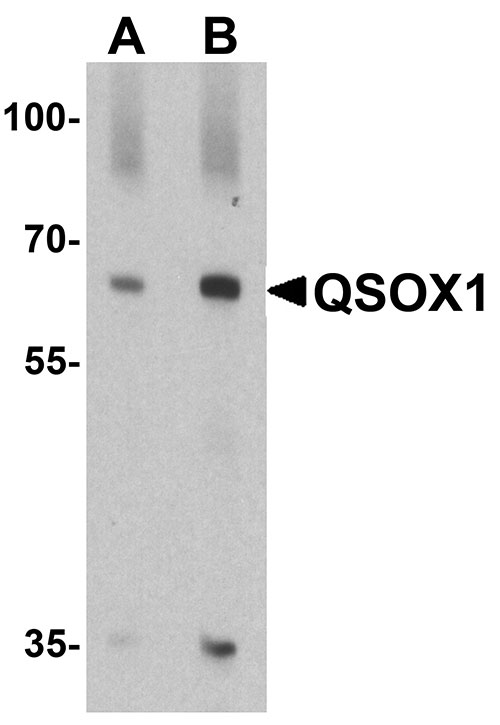QSOX1 Antibody
- 产品详情
- 实验流程
- 背景知识
Application
| WB, IF, E |
|---|---|
| Primary Accession | O00391 |
| Other Accession | NP_002817, 13325075 |
| Reactivity | Human, Mouse |
| Host | Rabbit |
| Clonality | Polyclonal |
| Isotype | IgG |
| Calculated MW | 82578 Da |
| Concentration (mg/ml) | 1 mg/mL |
| Conjugate | Unconjugated |
| Application Notes | QSOX1 antibody can be used for detection of QSOX1 by Western blot at 1 - 2 µg/ml. For immunofluorescence start at 20 µg/mL. |
| Gene ID | 5768 |
|---|---|
| Other Names | Sulfhydryl oxidase 1, hQSOX, 1.8.3.2, Quiescin Q6, QSOX1, QSCN6 |
| Target/Specificity | QSOX1; QSOX1 antibody is human and mouse reactive. QSOX1 antibody is predicted to not cross-react with QSOX2. |
| Reconstitution & Storage | QSOX1 antibody can be stored at 4℃ for three months and -20℃, stable for up to one year. |
| Precautions | QSOX1 Antibody is for research use only and not for use in diagnostic or therapeutic procedures. |
| Name | QSOX1 |
|---|---|
| Synonyms | QSCN6 {ECO:0000303|PubMed:9878249} |
| Function | Catalyzes the oxidation of sulfhydryl groups in peptide and protein thiols to disulfides with the reduction of oxygen to hydrogen peroxide (PubMed:17331072, PubMed:18393449, PubMed:23704371, PubMed:23867277, PubMed:30367560). Plays a role in disulfide bond formation in a variety of extracellular proteins (PubMed:17331072, PubMed:22801504, PubMed:23867277, PubMed:30367560). In fibroblasts, required for normal incorporation of laminin into the extracellular matrix, and thereby for normal cell-cell adhesion and cell migration (PubMed:23704371, PubMed:23867277, PubMed:30367560). |
| Cellular Location | [Isoform 1]: Golgi apparatus membrane; Single-pass membrane protein. Secreted. Note=A small proportion is secreted, probably via a proteolytic cleavage that removes the membrane anchor |
| Tissue Location | Expressed in heart, placenta, lung, liver, skeletal muscle, pancreas and very weakly in brain and kidney {ECO:0000269|PubMed:10708601, ECO:0000269|Ref.8} |
For Research Use Only. Not For Use In Diagnostic Procedures.
Provided below are standard protocols that you may find useful for product applications.
BACKGROUND
The QSOX1 gene, also known as Quiescin Q6, is a fusion of two ancient genes: thioredoxin and ERV1. Its expression is induced as fibroblasts begin to exit the proliferative cycle and enter quiescence, suggesting that this gene plays an important role in growth regulation (1). The QSOX1 protein oxidizes sulfhydryl groups to form disulfide bonds in proteins. QSOX1 expression is induced by hypoxia (2) and appears to protect cells against oxidative stress-induced apoptosis (3).
REFERENCES
Coppock DL, Cina-Poppe D, and Gilleran S. The quiescin Q6 gene (QSCN6) is a fusion of two ancient gene families: thioredoxin and ERV1. Genomics 1998; 54:460-8.
Shi CY, Fan Y, Liu B, et al. HIF1 contributes to hypoxia-induced pancreatic cancer cells invasion via promoting QSOX1 expression. Cell Physiol. Biochem. 2013; 32:561-8.
Morel C, Adami P, Musard JF, et al. Involvement of sulfhydryl oxidase QSOX1 in the protection of cells against oxidative stress-induced apoptosis. Exp. Cell Res. 2007; 313:3971-82.
终于等到您。ABCEPTA(百远生物)抗体产品。
点击下方“我要评价 ”按钮提交您的反馈信息,您的反馈和评价是我们最宝贵的财富之一,
我们将在1-3个工作日内处理您的反馈信息。
如有疑问,联系:0512-88856768 tech-china@abcepta.com.























 癌症的基本特征包括细胞增殖、血管生成、迁移、凋亡逃避机制和细胞永生等。找到癌症发生过程中这些通路的关键标记物和对应的抗体用于检测至关重要。
癌症的基本特征包括细胞增殖、血管生成、迁移、凋亡逃避机制和细胞永生等。找到癌症发生过程中这些通路的关键标记物和对应的抗体用于检测至关重要。 为您推荐一个泛素化位点预测神器——泛素化分析工具,可以为您的蛋白的泛素化位点作出预测和评分。
为您推荐一个泛素化位点预测神器——泛素化分析工具,可以为您的蛋白的泛素化位点作出预测和评分。 细胞自噬受体图形绘图工具为你的蛋白的细胞受体结合位点作出预测和评分,识别结合到自噬通路中的蛋白是非常重要的,便于让我们理解自噬在正常生理、病理过程中的作用,如发育、细胞分化、神经退化性疾病、压力条件下、感染和癌症。
细胞自噬受体图形绘图工具为你的蛋白的细胞受体结合位点作出预测和评分,识别结合到自噬通路中的蛋白是非常重要的,便于让我们理解自噬在正常生理、病理过程中的作用,如发育、细胞分化、神经退化性疾病、压力条件下、感染和癌症。







